Finding the perfect haircut when you have thin, fine hair can feel like searching for a needle in a haystack, but the stacked inverted bob might just be your golden ticket to volume, style, and confidence.
This comprehensive guide explores the Best 37 Flattering Stacked Inverted Bob Haircuts for Thin Fine Hair, showcasing how strategic layering, precise angling, and expert stacking techniques can transform limp strands into a dimensional masterpiece.
Whether you’re looking for dramatic elevation at the crown, subtle texture throughout, or a bold geometric silhouette, the stacked inverted bob offers versatile solutions that create the illusion of thickness while maintaining easy maintenance.
From classic chin-length cuts to daring pixie-bob hybrids, each variation in this collection has been carefully selected to address the unique challenges of fine hair textures.
You’ll discover styling tips, maintenance secrets, and professional insights that will help you choose the perfect cut for your face shape, lifestyle, and personal aesthetic, proving once and for all that thin hair doesn’t mean compromising on style or sophistication.
Contents
- 1 1. Classic Stacked Inverted Bob with Maximum Volume
- 2 2. Textured Choppy Stacked Bob for Edgy Dimension
- 3 3. Blunt-Cut Stacked Bob with Sharp Angles
- 4 4. Soft Layered Stacked Bob for Natural Movement
- 5 5. Asymmetrical Stacked Bob with Dramatic Side-Sweep
- 6 6. Stacked Bob with Undercut for Enhanced Volume Contrast
- 7 7. Stacked Bob with Wispy Bangs for Face-Framing Fullness
- 8 8. Rounded Stacked Bob for Maximum Crown Volume
- 9 9. Graduated Stacked Bob with Nape Exposure
- 10 10. Stacked Bob with Balayage for Dimensional Depth
- 11 11. Micro-Stacked Bob for Subtle Volume Enhancement
- 12 12. Stacked Bob with Side Part for Asymmetrical Volume
- 13 13. Stacked Bob with Curved Layers for Soft Movement
- 14 14. Stacked Pixie-Bob Hybrid for Maximum Short Volume
- 15 15. Disconnected Stacked Bob for Modern Edge
- 16 16. Stacked Bob with Root Lift Technique Consideration
- 17 17. Stacked Bob with Tousled Texture for Casual Fullness
- 18 18. Precision-Stacked Bob for Sleek Sophistication
- 19 19. Stacked Bob with Fringe Variations for Customization
- 20 20. Stacked Bob with Strategic Color Placement
- 21 21. Stacked Bob with Piecey Separation for Texture
- 22 22. Angled Stacked Bob with Jaw-Skimming Length
- 23 23. Stacked Bob with Volume-Boosting Cut Techniques
- 24 24. Stacked Bob with Nape Detailing Options
- 25 25. Stacked Bob with Styling Product Considerations
- 26 26. Stacked Bob for Different Age Groups
- 27 27. Stacked Bob with Face-Framing Highlights
- 28 28. Stacked Bob with Crown Teasing Techniques
- 29 29. Stacked Bob with Thermal Styling Considerations
- 30 30. Stacked Bob for Different Hair Densities Within Fine Texture
- 31 31. Stacked Bob with Seasonal Styling Adaptations
- 32 32. Stacked Bob with Transition from Long Hair
- 33 33. Stacked Bob with Nighttime Hair Care Routines
- 34 34. Stacked Bob with Professional Consultation Essentials
- 35 35. Stacked Bob with Color Correction Opportunities
- 36 36. Stacked Bob with Texture vs. Smoothness Balance
- 37 37. Stacked Bob with Confidence-Building Transformation
- 38 Conclusion
1. Classic Stacked Inverted Bob with Maximum Volume
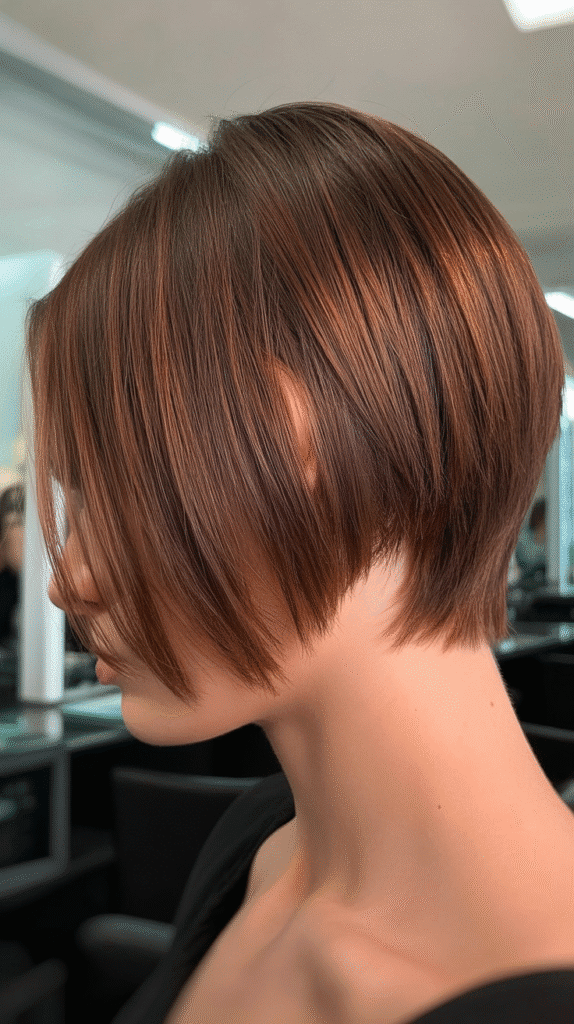
The classic stacked inverted bob remains the foundation of all variations, featuring dramatic graduation from short nape layers to longer front pieces that create instant fullness.
This timeless cut uses precision stacking at the back to build height where fine hair needs it most.
- The graduated layers at the nape are cut progressively shorter, creating a rounded shape that adds dimensional volume without requiring excessive product or styling effort.
- Front sections typically fall between chin and collarbone length, drawing the eye forward while the stacked back provides structural support and prevents the flat appearance common with fine hair.
- This cut works exceptionally well for oval, heart, and square face shapes, as the angle softens angular features while the volume balances proportions.
- Styling requires minimal effort—a round brush during blow-drying enhances the natural lift, while the stacked layers hold their shape throughout the day without constant touch-ups.
- The dramatic difference in length from back to front creates visual interest and movement, making hair appear thicker and more abundant than its actual density.
2. Textured Choppy Stacked Bob for Edgy Dimension
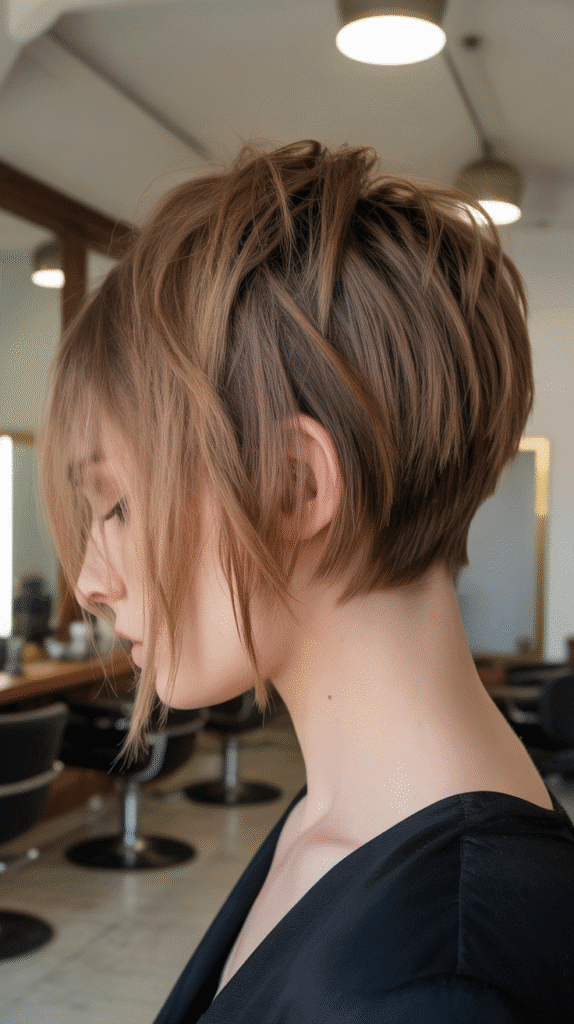
Incorporating choppy, textured layers into the stacked inverted bob adds an edgy, modern twist that creates the illusion of density through intentional imperfection.
This variation uses point-cutting and razor techniques to break up the uniform appearance of fine hair.
- Point-cutting throughout the ends creates irregular texture that catches light differently, making individual strands more visible and creating the perception of fuller hair.
- The choppy layers prevent hair from clumping together, which is a common issue with fine textures that can make hair appear thinner than it actually is.
- This style works particularly well for those with naturally straight fine hair, as the texture prevents the sleek, flat look that can emphasize thinness.
- Styling products like texturizing sprays, dry shampoo, and sea salt sprays enhance the piecey separation and maintain the deliberate disheveled appearance throughout the day.
- The combination of stacked volume at the back with choppy texture throughout creates a multidimensional effect that addresses both volume and density concerns simultaneously.
3. Blunt-Cut Stacked Bob with Sharp Angles
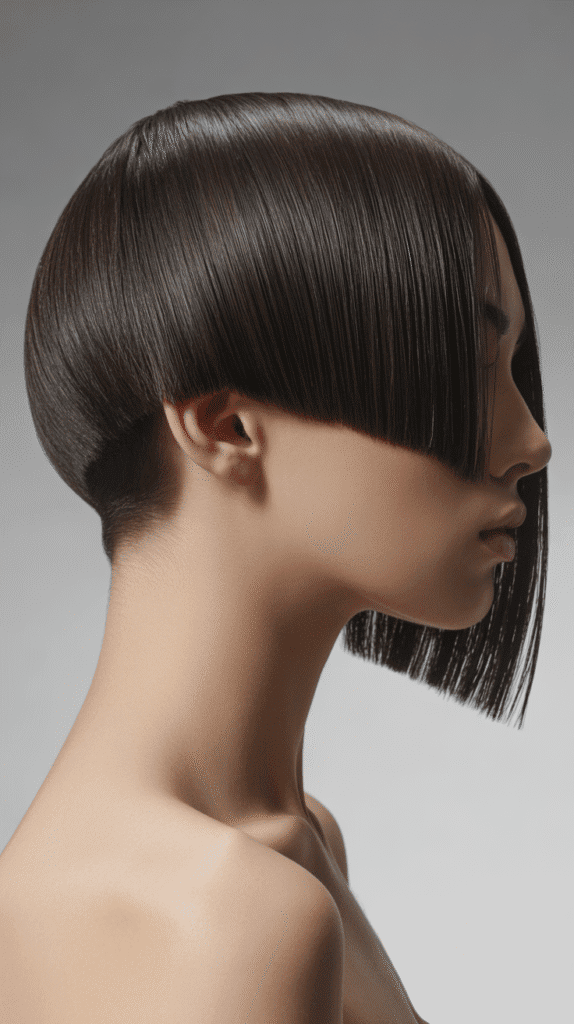
The blunt-cut approach to the stacked inverted bob creates clean, sharp lines that make fine hair appear intentionally sleek rather than accidentally thin.
This precision technique uses weight distribution to maximize the appearance of density.
- Blunt cutting maintains the maximum weight at the perimeter, creating a solid, dense appearance that doesn’t reveal scalp or thinness as layered cuts sometimes can.
- The sharp angle from back to front creates a geometric silhouette that’s both fashion-forward and flattering, drawing attention to the intentional design rather than hair texture.
- This cut requires regular maintenance every 4-6 weeks to preserve the crisp lines, but the precision actually makes fine hair look more expensive and deliberately styled.
- The stacked back provides necessary volume while the blunt front sections create a curtain effect that frames the face without revealing the thinness of individual strands.
- This style works exceptionally well for straight fine hair and can be enhanced with glossing treatments that add shine to emphasize the clean, architectural lines.
4. Soft Layered Stacked Bob for Natural Movement

For those preferring a gentler approach, the soft layered stacked bob incorporates subtle graduation that adds movement without sacrificing the volume-boosting benefits of stacking.
This feminine variation creates a romantic, flowing silhouette.
- Soft layers are cut at slight angles rather than dramatic graduations, creating gentle movement that appears natural and effortless rather than heavily styled.
- The stacking at the crown and back remains present but less pronounced, providing lift without the severe architectural quality of more dramatic versions.
- This cut is ideal for those with slightly wavy fine hair, as the subtle layers enhance natural texture without creating frizz or requiring extensive styling.
- The softer approach makes this variation more workplace-appropriate and versatile for various occasions, from professional settings to casual weekend activities.
- Styling focuses on enhancing natural movement with lightweight mousses and gentle wave sprays that don’t weigh down fine strands while maintaining the soft, flowing aesthetic.
5. Asymmetrical Stacked Bob with Dramatic Side-Sweep

The asymmetrical stacked bob takes volume creation to the next level by incorporating uneven lengths that create visual interest and draw attention away from hair density concerns.
This bold variation makes a strong style statement.
- One side is cut significantly shorter than the other, creating an intentional imbalance that adds contemporary edge while the stacked back maintains structural volume.
- The dramatic side-sweep directs hair across the face, creating a focal point that shifts attention to the artistic design rather than individual strand thickness.
- This cut works particularly well for those with oval or long face shapes, as the asymmetry breaks up vertical length and adds width where needed.
- The longer side can be styled in various ways—tucked behind the ear for a sleek look or left forward for maximum drama and face-framing effect.
- Maintenance requires precision trimming to preserve the asymmetrical lines, but the bold design makes thin hair appear intentionally styled and fashion-forward rather than problematic.
6. Stacked Bob with Undercut for Enhanced Volume Contrast

Incorporating an undercut into the stacked inverted bob removes bulk from the nape while emphasizing the volume of the stacked layers above, creating maximum contrast that makes fine hair appear exponentially fuller.
This edgy technique offers practical and aesthetic benefits.
- The undercut removes the bottom layers of hair at the nape, which are often the thinnest and most problematic for fine hair textures, creating a clean foundation.
- By removing weight from below, the remaining stacked layers appear more voluminous in comparison, creating an optical illusion of significantly thicker hair.
- This technique also reduces drying time and makes styling easier, as there’s less hair to manage while maintaining the appearance of a full, voluminous style.
- The undercut can be customized from subtle (barely visible) to dramatic (extending higher up the head), allowing personalization based on comfort level and desired impact.
- This style requires regular maintenance to keep the undercut clean, but many find the volume benefits and reduced styling time worth the commitment to frequent trims.
7. Stacked Bob with Wispy Bangs for Face-Framing Fullness
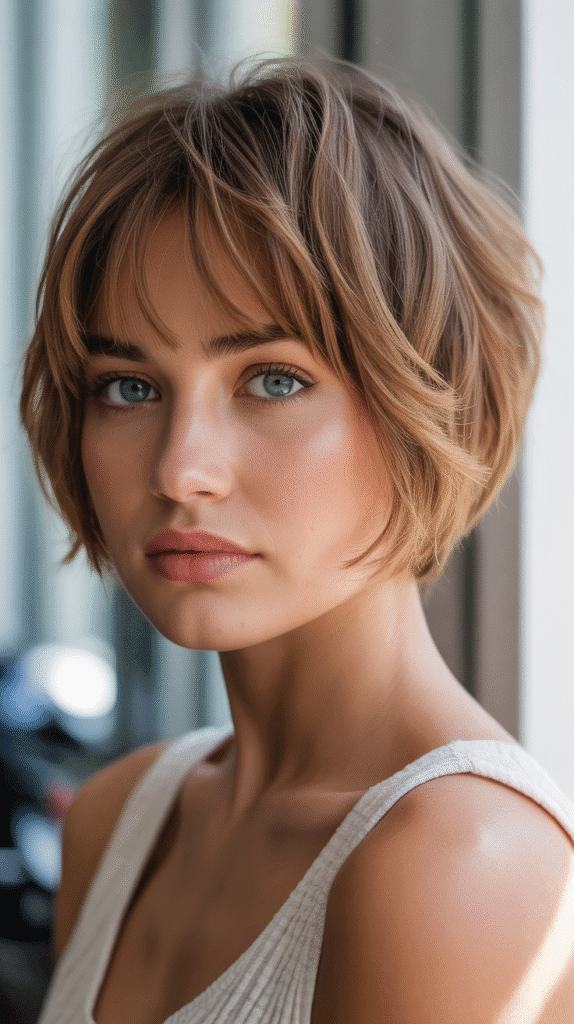
Adding wispy bangs to a stacked inverted bob creates additional face-framing dimension while solving the common fine-hair problem of a visible forehead or sparse hairline.
This combination offers comprehensive coverage and style.
- Wispy bangs are cut with texturizing techniques that prevent the heavy, solid appearance of traditional bangs, which can emphasize hair thinness by contrast.
- The feathered, irregular edges of wispy bangs blend seamlessly with the angled front pieces of the inverted bob, creating a cohesive, flowing style.
- This variation effectively camouflages larger foreheads or receding hairlines, common concerns for those with fine hair, while adding youthful dimension to the overall look.
- The bangs require minimal styling—simply blow-drying forward with fingers creates the desired wispy effect without need for extensive brush work or product application.
- This style works across age ranges and face shapes, with bang length and density customizable to suit individual features and maintenance preferences.
8. Rounded Stacked Bob for Maximum Crown Volume
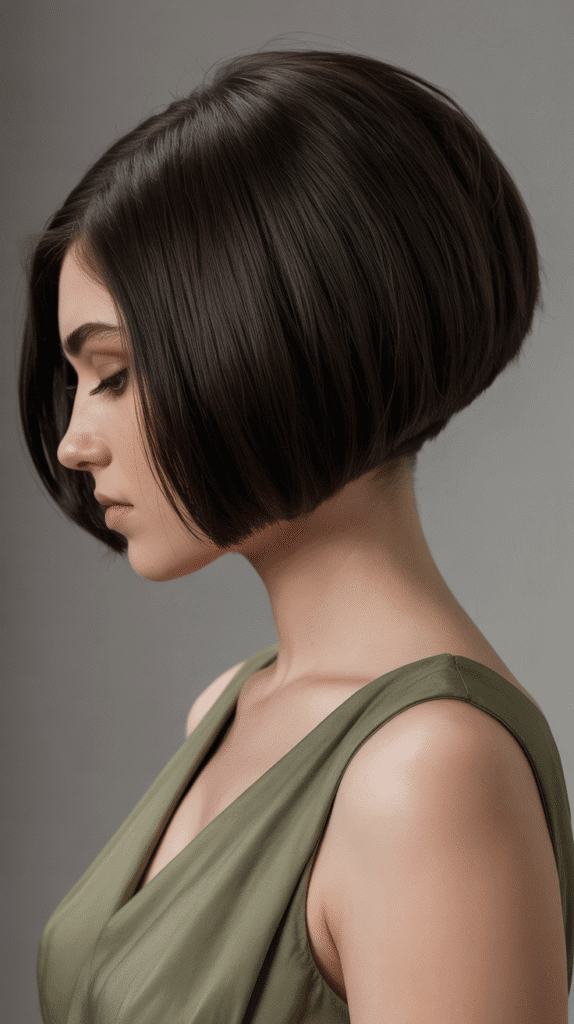
The rounded stacked bob focuses on creating a distinctive bubble shape at the crown, strategically placing maximum volume where fine hair tends to fall flattest.
This technique uses circular layering to build impressive height.
- Layers are cut in a curved pattern radiating from the crown, creating a rounded silhouette that lifts away from the scalp and maintains its shape without constant restyling.
- This cut is particularly effective for those with completely straight fine hair, as the circular stacking fights against the natural tendency to lie flat against the head.
- The rounded shape creates a retro-inspired aesthetic reminiscent of 1960s mod styles, offering a vintage charm with modern precision cutting techniques.
- Styling focuses on blow-drying with a round brush at the crown, directing hair up and away from the scalp to maximize the rounded effect and maintain volume throughout the day.
- This variation works especially well for petite individuals or those with smaller heads, as the rounded volume creates balanced proportions and prevents the head from appearing disproportionately small.
9. Graduated Stacked Bob with Nape Exposure
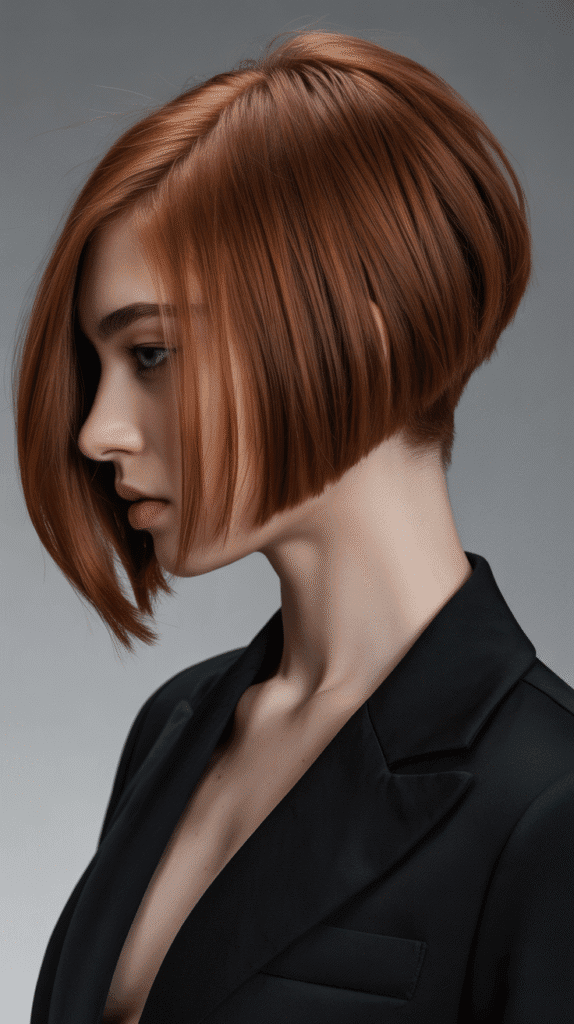
The graduated stacked bob with nape exposure takes the stacking concept to its extreme, creating maximum height contrast by fully exposing the nape while maintaining longer front sections.
This dramatic variation offers bold visual impact.
- The nape is cut very short, sometimes as close as one inch, creating a clean, exposed look that emphasizes the graduated stacking above and prevents any appearance of thinness.
- The extreme length difference from back to front creates a dramatic swooping line that becomes a signature feature, making thin hair density irrelevant to the overall impact.
- This cut provides excellent cooling benefits and is ideal for those who dislike hair touching their neck, offering practical comfort alongside aesthetic benefits.
- The exposed nape requires attention to skin care and occasional hair removal or edge maintenance to keep the look polished and intentional.
- This bold style works best for those with confidence and willingness to stand out, as the dramatic proportions create a statement look that draws attention and compliments.
10. Stacked Bob with Balayage for Dimensional Depth
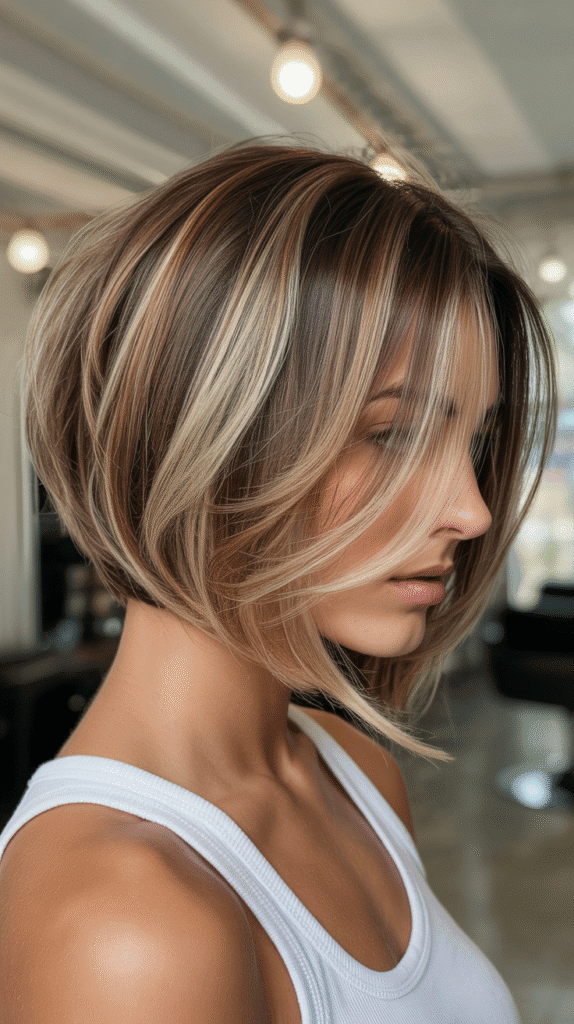
Combining a stacked inverted bob with balayage color technique creates multi-dimensional depth that makes fine hair appear thicker through strategic color placement.
This approach addresses volume through both cut and color.
- Balayage highlights are hand-painted to emphasize the stacked layers, with lighter pieces concentrated at the crown and throughout the layers to create visual dimension and depth.
- The color variation creates shadows and highlights that make individual layers more distinguishable, giving the appearance of more hair volume than actually exists.
- Strategic placement of lighter tones at the stacked back draws light and attention to the volume-rich area, while darker roots maintain depth and prevent the flat appearance of solid color.
- The low-maintenance nature of balayage makes it ideal for fine hair, as frequent touch-ups aren’t necessary and the grown-out look maintains dimension without appearing neglected.
- This combination works across all hair colors, from blonde to brunette to red, with the color contrast customized to complement natural tones while maximizing the volumizing effect.
11. Micro-Stacked Bob for Subtle Volume Enhancement
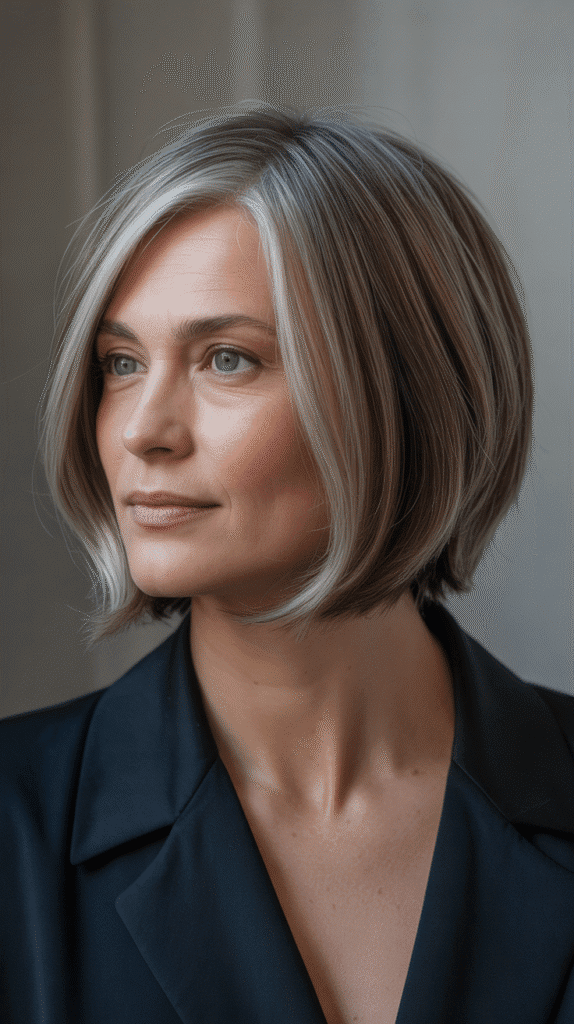
For those seeking volume benefits without dramatic styling, the micro-stacked bob incorporates subtle graduation that enhances fullness while maintaining a more conservative, classic appearance.
This understated variation offers professional polish.
- The stacking is graduated more gently than dramatic versions, with only slight elevation differences between layers that create volume without obvious architectural styling.
- This approach is ideal for conservative work environments or those who prefer classic styling, as the volume enhancement appears natural rather than intentionally structured.
- The subtle stacking still provides lift at the crown and prevents the flat appearance common with one-length bobs on fine hair, but in a less noticeable way.
- Styling is incredibly simple—standard blow-drying creates sufficient volume without requiring specific techniques, making this cut ideal for those with limited styling time or skills.
- This variation works well across all age groups and is particularly popular with mature women seeking age-appropriate volume without trendy or edgy styling elements.
12. Stacked Bob with Side Part for Asymmetrical Volume
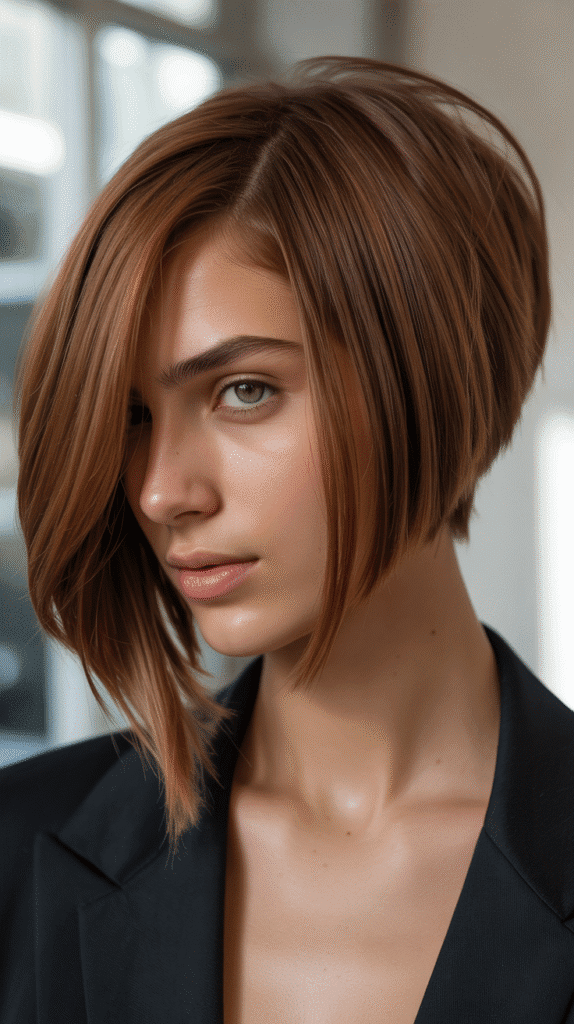
Incorporating a deep side part into a stacked inverted bob creates asymmetrical volume distribution that adds interest while maximizing fullness on the heavier side.
This simple styling change transforms the cut’s appearance.
- A deep side part places more hair on one side, creating concentrated volume and weight that makes fine hair appear fuller where it matters most for face-framing.
- The side with more hair naturally falls forward, creating a swooping curtain effect that adds drama and movement while the lighter side showcases the ear and jawline.
- This styling works with the natural growth pattern for many people, making it easier to maintain the part placement without constant adjustment throughout the day.
- The asymmetry created by the side part adds visual interest and draws attention away from overall hair density by focusing on intentional styling choices instead.
- This versatile approach can be changed periodically by switching the part to the opposite side, essentially creating two different looks from the same haircut.
13. Stacked Bob with Curved Layers for Soft Movement
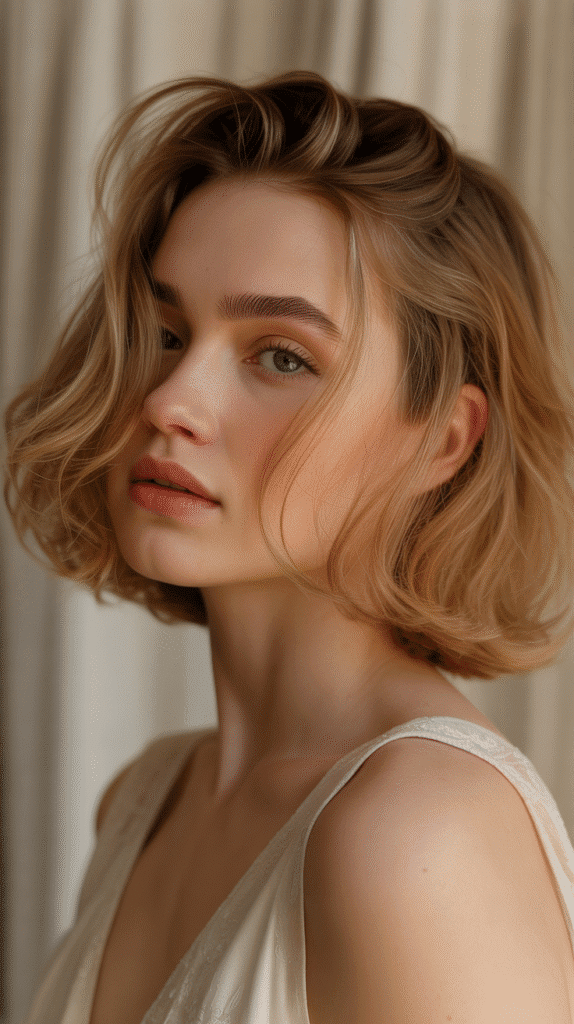
The curved-layer stacked bob uses convex cutting lines rather than straight graduation, creating softer, more flowing movement that’s particularly flattering for fine hair.
This technique adds femininity while maintaining volume.
- Curved layers follow the natural shape of the head, creating a more organic, flowing silhouette that moves naturally with head movement rather than maintaining rigid structure.
- This cutting technique is particularly effective for those with slight natural wave in fine hair, as the curved layers enhance the wave pattern and prevent the stringy appearance straight layers can create.
- The soft curves create a romantic, approachable aesthetic that’s less severe than geometric straight-line stacking while still providing essential crown volume.
- Styling emphasizes the natural movement through loose blow-drying or air-drying with lightweight curl-enhancing products that don’t weigh down fine strands.
- This variation is ideal for those seeking volume benefits without the high-maintenance or edgy appearance of more dramatic stacked styles.
14. Stacked Pixie-Bob Hybrid for Maximum Short Volume
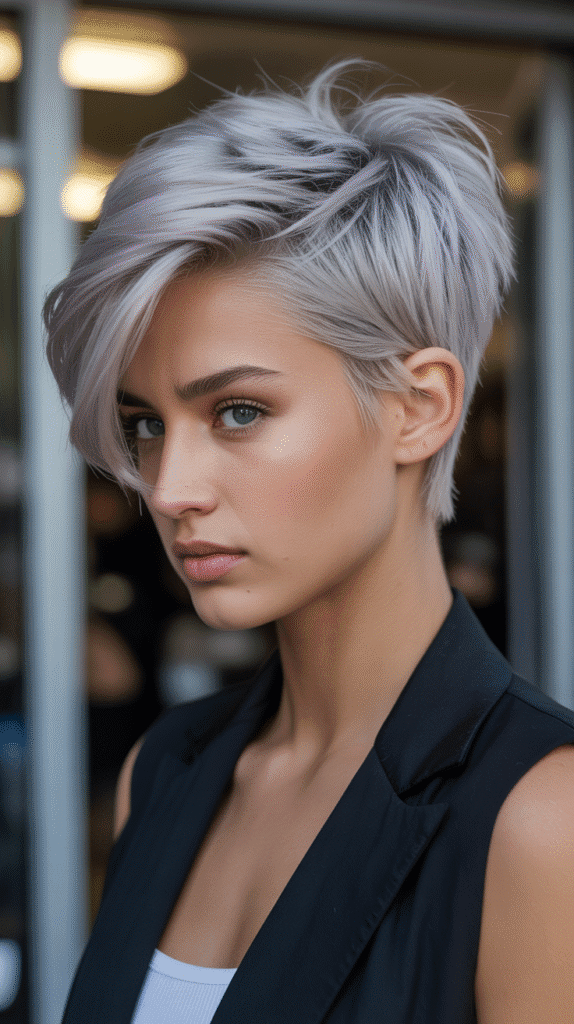
The stacked pixie-bob hybrid combines the dramatic volume of pixie stacking with the slightly longer length of a bob, creating an ultra-short option that maximizes fullness for very fine hair.
This bold cut offers transformative results.
- The back and sides are cut very short with dramatic stacking, creating maximum lift and volume while keeping the overall length manageable for those transitioning from longer styles.
- The front and top sections remain slightly longer (typically 2-4 inches), providing enough length to style forward while maintaining the voluminous stacked shape in back.
- This cut virtually eliminates the appearance of thin hair by removing most of the length where thinness is visible, focusing instead on creating strategic volume in key areas.
- Styling is remarkably quick—a small amount of volumizing mousse worked through damp hair and finger-styled during drying creates the desired effect with minimal effort.
- This transformation works exceptionally well for those ready to embrace shorter hair and prioritize volume and ease over length, offering dramatic before-and-after impact.
15. Disconnected Stacked Bob for Modern Edge
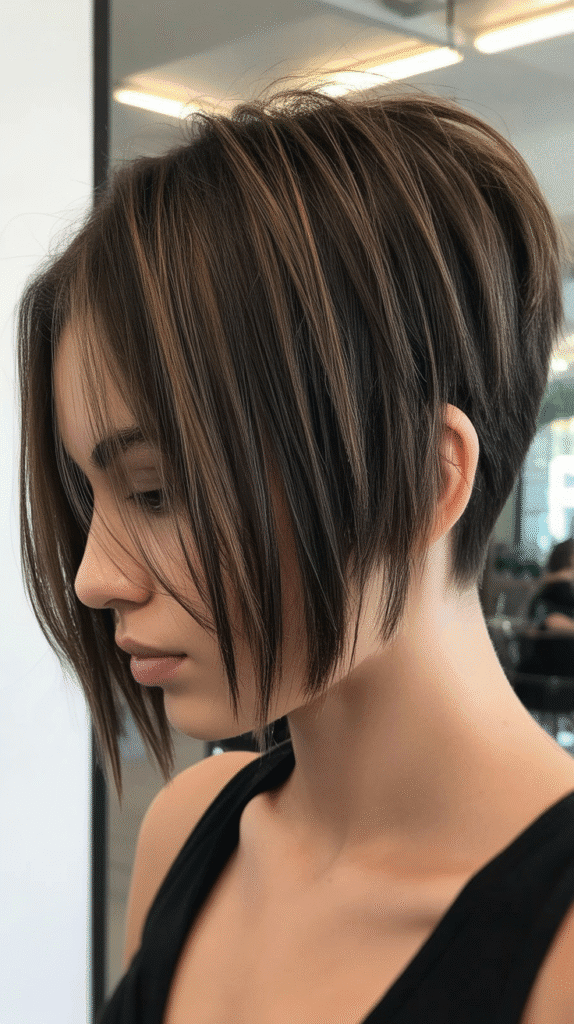
The disconnected stacked bob incorporates intentional gaps between layer sections, creating a modern, editorial look that adds dimension and prevents the solid, heavy appearance that can emphasize fineness.
This avant-garde variation pushes creative boundaries.
- Disconnected layers are cut at deliberately different lengths without blending, creating visible separation that adds visual interest and makes fine hair appear more abundant through textural variation.
- This technique works particularly well with straight fine hair, as the disconnection is most visible and impactful when hair lies relatively smooth rather than curling or waving.
- The modern, fashion-forward appearance makes thin hair look intentionally styled rather than problematic, shifting the focus to artistic design choices.
- Styling requires some expertise—smoothing some sections while texturizing others creates the desired disconnected effect and emphasizes the intentional separation between layers.
- This cut requires a skilled stylist experienced with modern cutting techniques and may need more frequent maintenance to preserve the precise disconnected sections.
16. Stacked Bob with Root Lift Technique Consideration

While the cut itself provides structural volume, understanding proper root lift techniques transforms a stacked inverted bob from good to exceptional for fine hair.
This section focuses on cutting considerations that facilitate easier styling.
- The cutting angle can be adjusted to work with natural growth patterns, making it easier to achieve lift at the crown without fighting against how hair naturally wants to grow.
- Shorter layers at the crown are cut to the optimal length for maximum lift—typically 2-3 inches—which allows hair to stand away from the scalp without being too short to style.
- The stylist should consider the client’s daily styling routine when determining stacking height, as more dramatic stacking requires more styling effort to maintain throughout the day.
- Point-cutting the interior layers slightly can reduce bulk that weighs down fine hair, while maintaining the exterior silhouette that creates the desired shape and volume appearance.
- Discussion with the stylist about typical styling products and tools helps customize the cut to work with individual habits, ensuring the volume is achievable in daily life, not just in the salon.
17. Stacked Bob with Tousled Texture for Casual Fullness
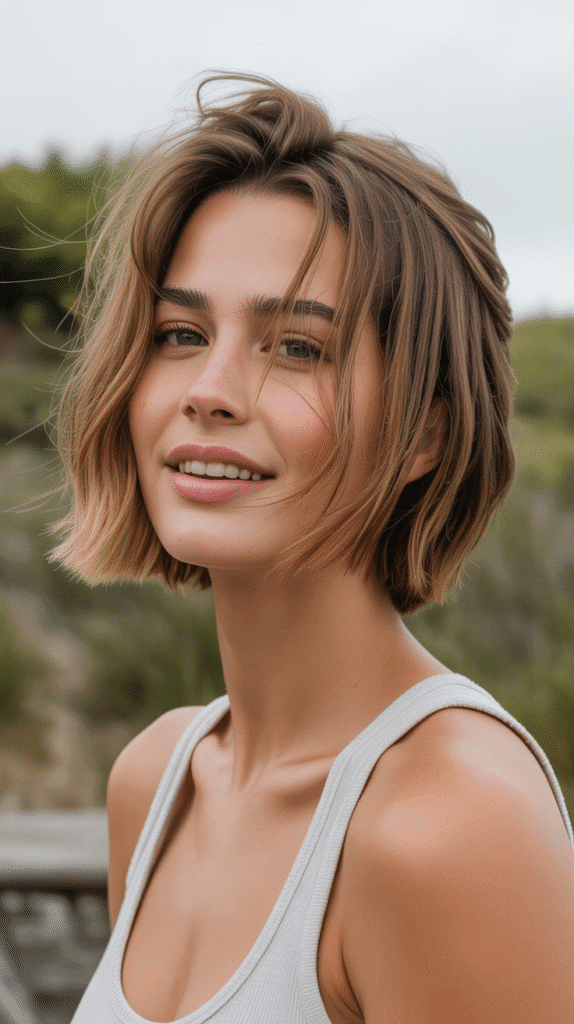
The tousled texture approach to the stacked inverted bob creates an effortlessly full appearance through intentional messiness that masks fine hair’s tendency toward flatness.
This low-maintenance variation offers relaxed style.
- Tousled styling uses texturizing products and scrunching techniques to create deliberate dishevelment that makes hair appear thicker through random, multidirectional movement.
- This style works exceptionally well for off-duty days, weekends, or casual work environments where polished perfection isn’t required, offering versatile styling options from the same cut.
- The casual approach actually benefits from fine hair’s tendency to hold texture, as the lightweight strands maintain the tousled shape without dropping or becoming overly oily quickly.
- Air-drying with sea salt spray or texturizing cream eliminates the need for heat styling, making this an ideal option for those seeking to minimize hair damage or styling time.
- The intentionally undone appearance shifts perception away from hair density concerns by making the “imperfect” texture the focal point rather than a problem to overcome.
18. Precision-Stacked Bob for Sleek Sophistication

The precision-stacked bob emphasizes exact angles and perfect lines, creating a sophisticated, polished look that makes fine hair appear intentionally sleek rather than accidentally thin.
This refined variation requires expert cutting skills.
- Every layer is cut with mathematical precision to create perfect angles and graduated lengths that form a flawless silhouette, emphasizing intentional design over natural texture.
- The precision cutting creates clean lines that reflect light uniformly, adding shine that makes fine hair appear healthier and more abundant than textured, matte finishes.
- This style works exceptionally well for straight fine hair and is ideal for professional environments or those who prefer classic, timeless aesthetics over trendy variations.
- Maintenance requires regular trims every 4-5 weeks to preserve the precise lines, but the sophisticated appearance makes fine hair look expensive and deliberately styled.
- Smoothing treatments or glosses can enhance the sleek appearance, though they’re not necessary—the precision cut alone creates sufficient impact for most fine hair types.
19. Stacked Bob with Fringe Variations for Customization
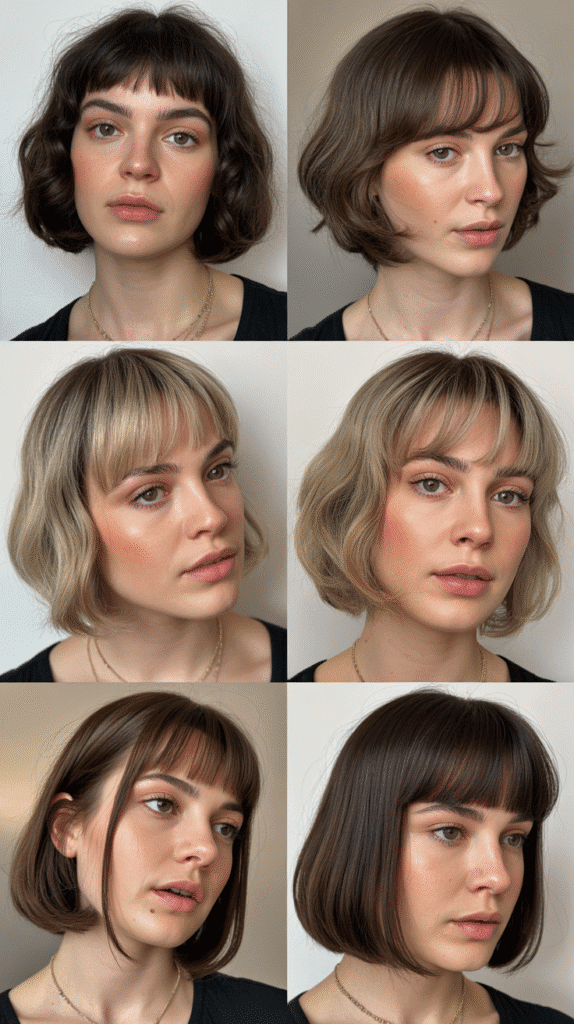
Exploring different fringe options with a stacked inverted bob allows extensive customization that addresses individual facial features while maintaining the volume benefits of stacking.
Various fringe styles offer different advantages for fine hair.
- Straight-across blunt bangs create maximum density at the forehead, using weight concentration to make fine hair appear fuller, though they require more frequent trimming and daily styling.
- Side-swept bangs offer a softer alternative that’s easier to manage with fine hair, as the diagonal angle prevents the separated, stringy appearance that can occur with straight bangs on thin hair.
- Curtain bangs parted in the center create face-framing volume on both sides while maintaining versatility—they can be worn forward as bangs or blended back into the cut when growing out.
- Micro-bangs create an edgy, fashion-forward look that draws attention to the eyes and away from hair density concerns, though this bold choice requires confidence and works best with specific face shapes.
- Leaving the forehead completely open without bangs showcases the stacked volume at the back and works well for those with strong facial features or who prefer minimal styling maintenance.
20. Stacked Bob with Strategic Color Placement

Beyond balayage, various strategic color placement techniques can enhance the volume appearance of a stacked inverted bob on fine hair.
Understanding color theory maximizes the optical illusions that make hair appear fuller.
- Darker colors at the roots and underneath create depth and shadow that make the lighter, volumized sections appear more prominent and dimensional, increasing perceived fullness.
- Highlights placed specifically at the stacked crown area draw light and attention to the voluminous sections, making them appear even more lifted and abundant than they naturally are.
- Face-framing highlights brighten the features and create the illusion of more hair around the face, where volume is most noticeable and impactful for overall appearance.
- Lowlights interspersed throughout prevent the flat, one-dimensional appearance that solid color creates, adding visual texture that mimics the appearance of more abundant hair.
- Avoiding overly light all-over color helps maintain depth—very light blonde or platinum can actually make fine hair appear thinner by reducing contrast and dimension.
21. Stacked Bob with Piecey Separation for Texture
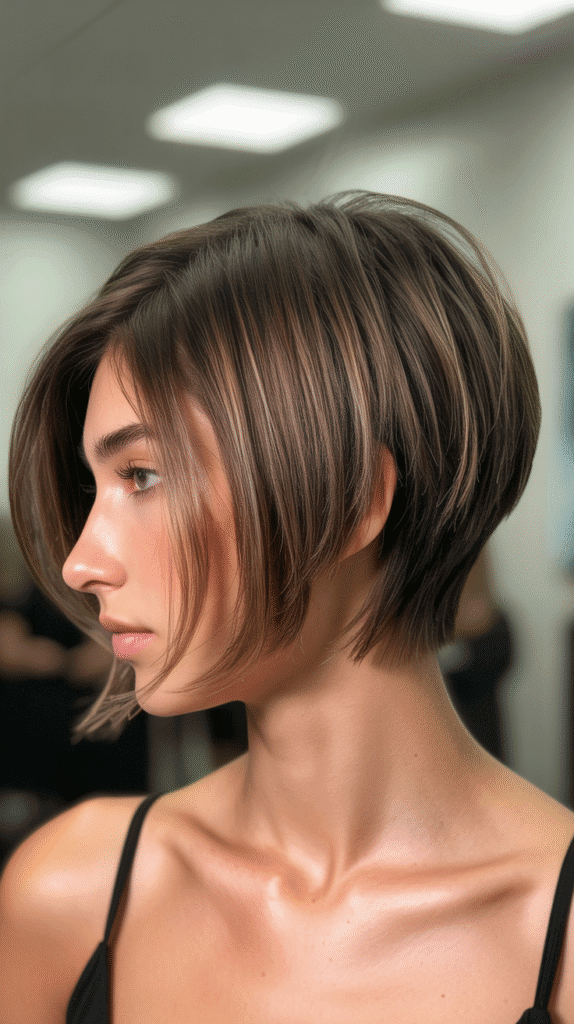
Creating piecey separation throughout a stacked inverted bob adds texture that makes individual sections of fine hair more visible and distinguishable, creating the illusion of greater volume through visual separation.
- Point-cutting and razor techniques create irregular ends that don’t clump together, allowing individual pieces to catch light separately and appear more abundant than uniform blunt cuts.
- Texturizing products applied to dry hair enhance the separated, piecey effect by adding grip and hold that prevents fine hair from immediately falling back into flat, merged sections.
- This technique works particularly well with the shorter layers at the back of the stacked cut, creating visible texture and dimension in the volume-building area.
- The piecey separation adds a contemporary, editorial quality to the cut that makes thin hair appear intentionally styled rather than problematically sparse.
- Styling emphasizes individual piece definition through finger-combing rather than brushing, which maintains the separation and prevents reverting to a smooth, flat appearance.
22. Angled Stacked Bob with Jaw-Skimming Length
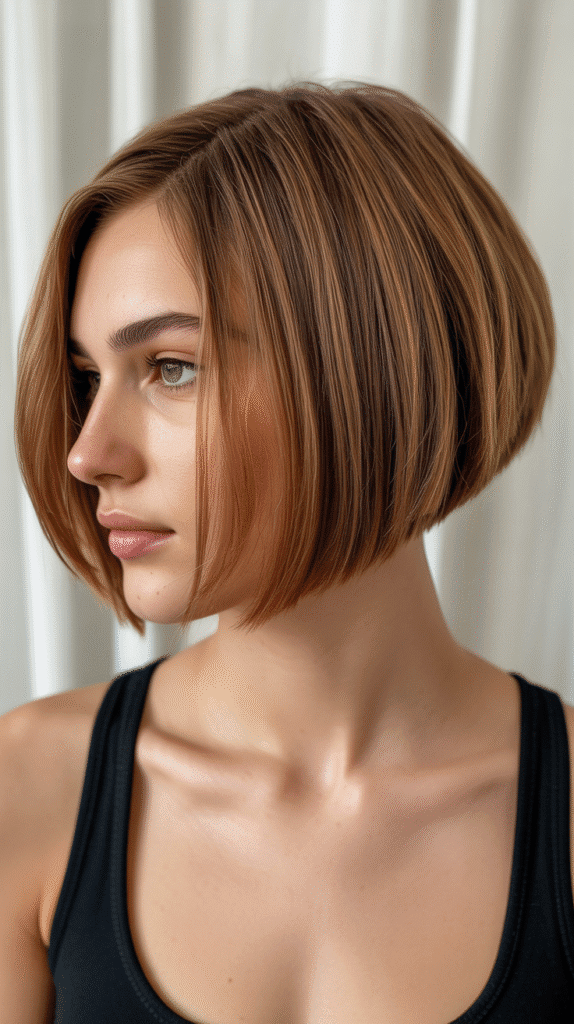
The jaw-skimming length for the front sections of an angled stacked bob creates an ideal balance—long enough to provide styling versatility but short enough to maintain body and prevent the weight-drag that causes fine hair to fall flat.
- Jaw-length front sections create perfect face-framing proportion, drawing attention to the jawline and cheekbones while the stacked back provides balanced volume.
- This length is universally flattering across face shapes, as it hits at a point that defines facial features without overwhelming smaller faces or getting lost on larger ones.
- The length is manageable for daily styling—long enough to tuck behind ears or style forward, but short enough to dry quickly and maintain volume throughout the day.
- Hair at this length typically has less damage than longer hair that’s been growing for years, making fine hair appear healthier and more abundant through better overall condition.
- This practical length works for various lifestyles, from active individuals who need manageable hair to professionals seeking polished styling without excessive time investment.
23. Stacked Bob with Volume-Boosting Cut Techniques

Understanding specific cutting techniques that maximize volume helps communicate with stylists and ensure the stacked bob delivers optimal fullness for fine hair.
These technical considerations make significant differences in final results.
- Slide cutting removes bulk from the interior while maintaining exterior density, creating layers that stack without the heavy, weighed-down feeling that can flatten fine hair.
- Channeling techniques create interior gaps that allow hair to lift and separate, providing space for volume without requiring removal of too much hair length or density.
- Crown elevation cutting—where the stylist holds hair at 90-degree angles from the head while cutting—creates natural lift that remains built into the cut even when styled.
- Graduation angles can be customized based on individual needs, with steeper angles (45+ degrees) creating more dramatic stacking and gentler angles (20-30 degrees) offering subtle volume.
- The cutting line direction—whether it follows a convex, concave, or straight path—affects how layers interact and stack, with concave lines creating maximum crown lift for fine hair.
24. Stacked Bob with Nape Detailing Options
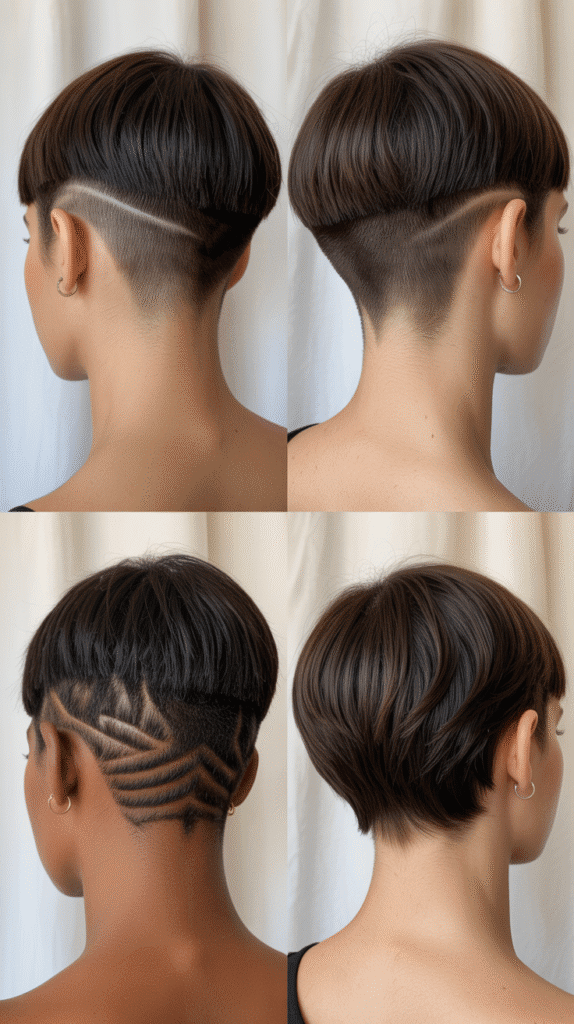
The nape area of a stacked inverted bob offers multiple finishing options that affect both aesthetic and maintenance requirements.
Understanding these variations helps customize the cut to individual preferences and hair growth patterns.
- A clean, shaved nape creates the most dramatic look and requires regular maintenance every 2-3 weeks, but provides maximum contrast that makes the stacked volume above appear more impressive.
- A tapered nape allows hair to grow to a subtle point, creating a softer, more feminine finish that requires less frequent maintenance while still providing clean definition.
- An undercut nape with designs or patterns adds artistic flair for those seeking personalized styling, though this requires skilled execution and frequent touch-ups to maintain clarity.
- A natural growth nape leaves the hairline unaltered, requiring minimal maintenance but potentially creating a less polished appearance as fine hair grows in irregular patterns.
- The neckline shape—whether curved, V-shaped, or straight—affects the overall silhouette and should be chosen based on individual neck shape and personal aesthetic preferences.
25. Stacked Bob with Styling Product Considerations
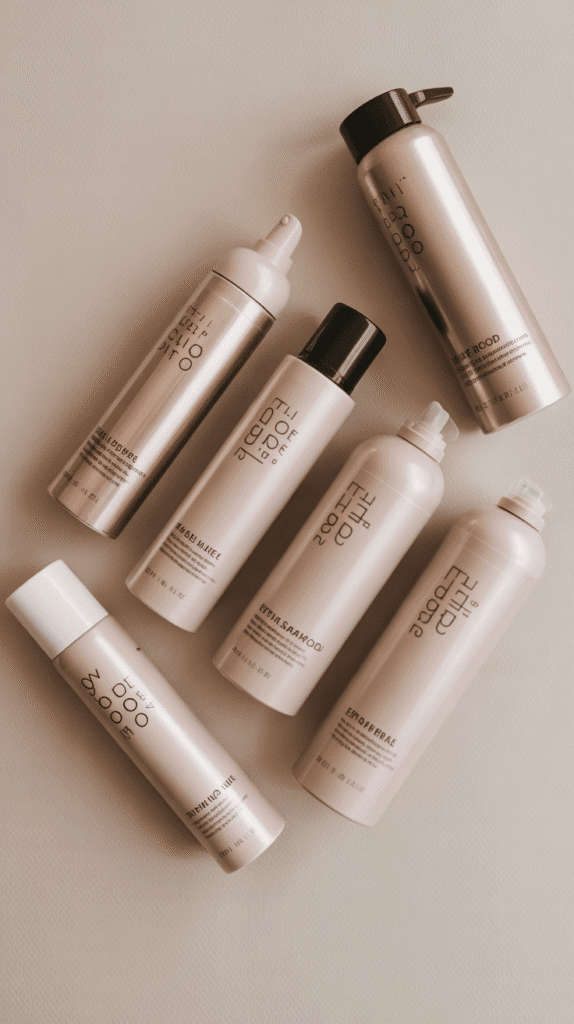
While the cut creates structural volume, choosing appropriate styling products makes the difference between a stacked bob that works daily versus one that only looks good immediately after salon styling.
Fine hair requires specific product considerations.
- Volumizing mousses applied to damp hair at the roots create lift without the stiffness or crunch that can make fine hair look unnatural or overly styled.
- Lightweight texture sprays add grip and separation without weighing down fine strands, helping maintain the piecey, dimensional appearance throughout the day.
- Dry shampoo serves double duty for fine hair—absorbing oil that causes flatness while adding texture and volume that enhances the stacked shape between washings.
- Avoiding heavy oils, serums, or cream-based products prevents the weighed-down appearance that causes fine hair to lose the volume benefits of strategic stacking.
- Strategic product placement matters—concentrating volume products at roots and texture products at ends maximizes benefits while preventing overload that causes flatness.
26. Stacked Bob for Different Age Groups
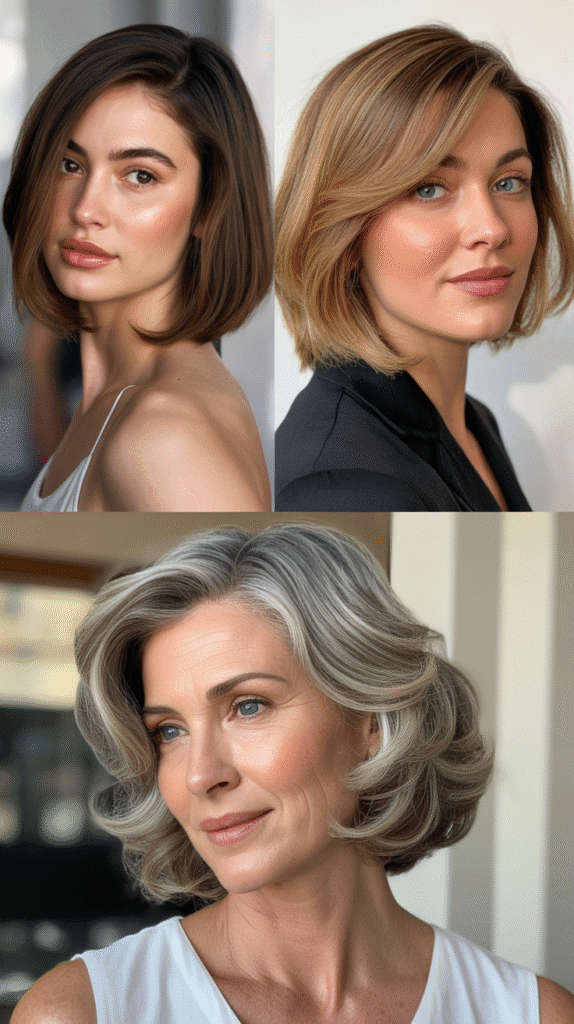
The stacked inverted bob adapts beautifully across age ranges, with modifications that make the style appropriate and flattering from teens through mature adults.
Understanding age-appropriate variations helps maximize the cut’s versatility.
- Younger clients (teens to 20s) often choose more dramatic stacking with edgy elements like asymmetry, bold colors, or undercuts that reflect contemporary fashion trends.
- Women in their 30s-40s typically prefer balanced stacking with professional polish, choosing versatile cuts that transition seamlessly from workplace to evening without requiring restyling.
- Mature clients (50+) often appreciate the stacked bob’s ability to combat age-related hair thinning, with softer stacking angles and face-framing layers that provide flattering volume without trendy elements.
- The cut addresses aging hairlines by removing length weight that pulls hair flat, using strategic volume placement to camouflage thinning areas around the crown and temples.
- Age-appropriate modifications include adjusting the angle severity, bang presence, and finishing details to align with personal style preferences that typically evolve with life stages.
27. Stacked Bob with Face-Framing Highlights
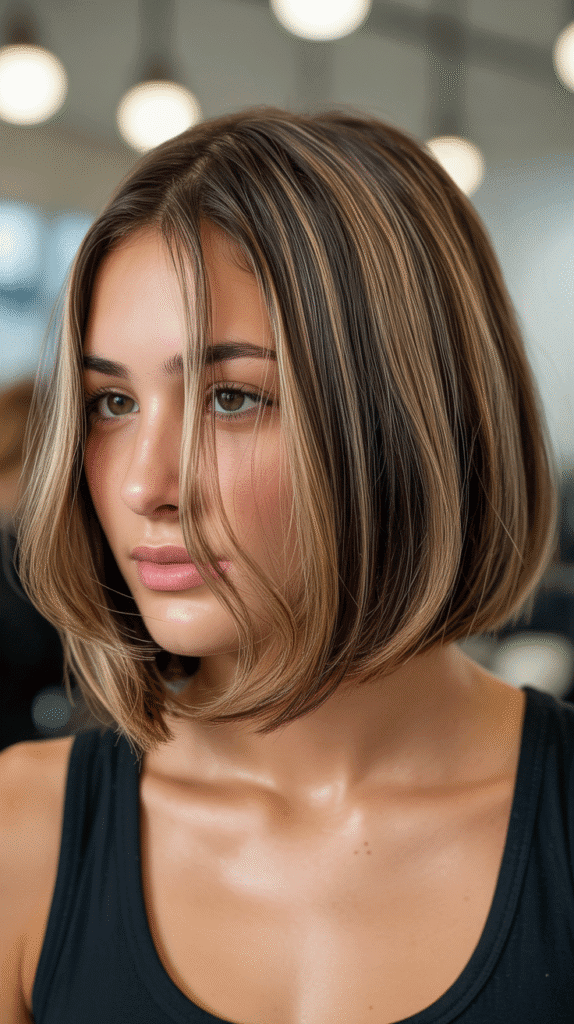
Strategic face-framing highlights combined with a stacked inverted bob create instant brightness and dimension that draws attention to facial features while making fine hair appear more voluminous through color contrast.
- Lighter pieces concentrated around the face create a brightening effect that highlights eyes and complexion while adding perceived density through dimensional color variation.
- The contrast between darker interior sections and lighter face-framing pieces creates depth that makes the overall cut appear fuller and more textured than single-process color.
- Face-framing highlights naturally grow out gracefully, requiring less maintenance than all-over color while still providing significant impact on the overall appearance.
- This technique works across all base colors—from adding caramel to brunette, honey to dark blonde, or platinum to light blonde—with the contrast level adjusted to individual preferences.
- The highlights enhance the angled front sections of the inverted bob, emphasizing the forward-sweeping lines and creating visual movement that complements the stacked structure.
28. Stacked Bob with Crown Teasing Techniques
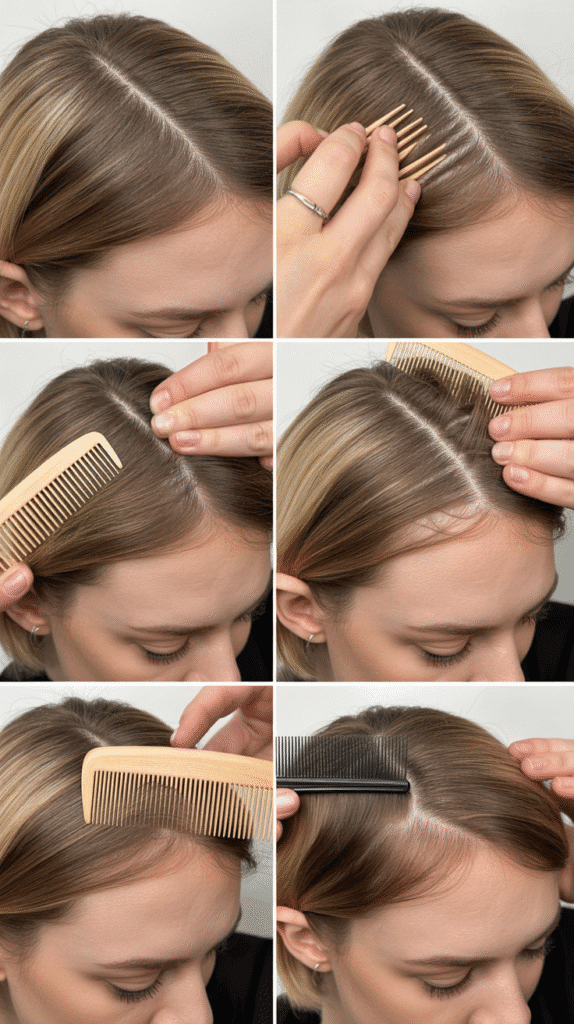
Understanding proper crown teasing methods transforms the volume potential of a stacked inverted bob, particularly for special occasions or when maximum height is desired.
These techniques complement the cut’s built-in structure.
- Gentle backcombing at the crown area, starting a few inches from the scalp, creates additional lift that works with the stacked layers rather than fighting against them.
- Using a fine-tooth comb for teasing provides more control with fine hair, preventing the over-teasing that can cause damage or create an unnatural, stiff appearance.
- Strategic teasing placement focuses on the already-stacked areas, enhancing the volume the cut naturally provides rather than trying to create lift where the cut doesn’t support it.
- Smoothing the outer layer over teased sections maintains a polished appearance while hiding the backcombing, creating volume that looks natural rather than obviously teased.
- Setting the teased volume with light hairspray before smoothing the surface ensures longevity without the heavy, crunchy texture that can make fine hair look unnatural or damaged.
29. Stacked Bob with Thermal Styling Considerations
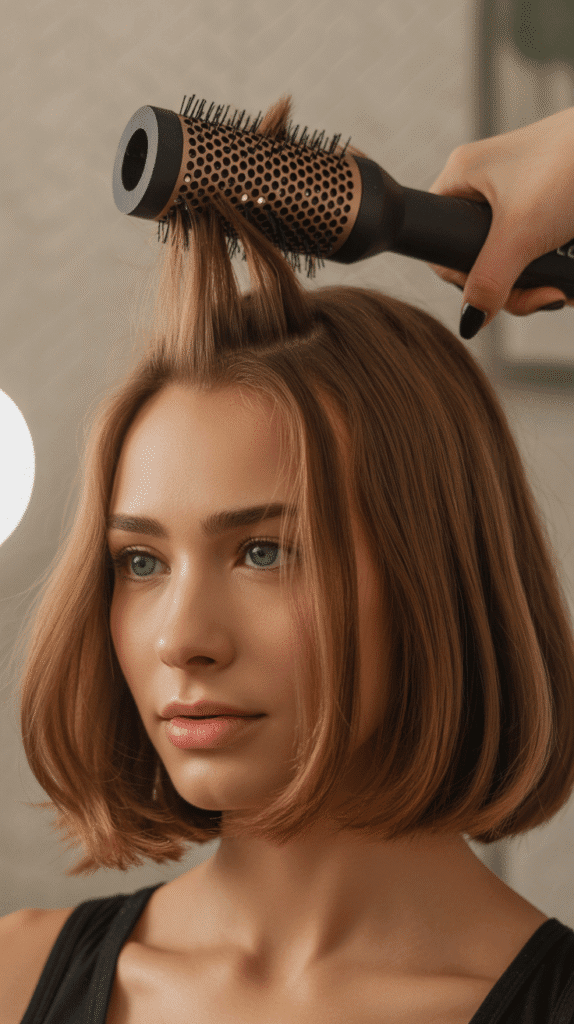
Thermal styling tools either enhance or undermine the stacked bob’s volume potential for fine hair.
Understanding proper heat styling techniques ensures the cut delivers its maximum benefits daily.
- Round brushes in appropriate sizes (typically 2-3 inches for bob lengths) create lift at the roots while smoothing the exterior, working with the stacked structure to maximize volume.
- Blow-drying upside down for the first few minutes creates instant root lift throughout the crown area before finishing with directional styling that shapes the front sections.
- Flat irons can actually add volume when used correctly—turning the wrist while pulling through sections creates bend and movement rather than stick-straight flatness that emphasizes thinness.
- Avoiding excessive heat on fine hair prevents damage that causes breakage and makes hair appear even thinner—using the lowest effective temperature setting protects hair integrity.
- Hot rollers provide volume without requiring advanced styling skills, as they create lift while cooling and can be placed strategically at the crown to enhance the stacked areas.
30. Stacked Bob for Different Hair Densities Within Fine Texture
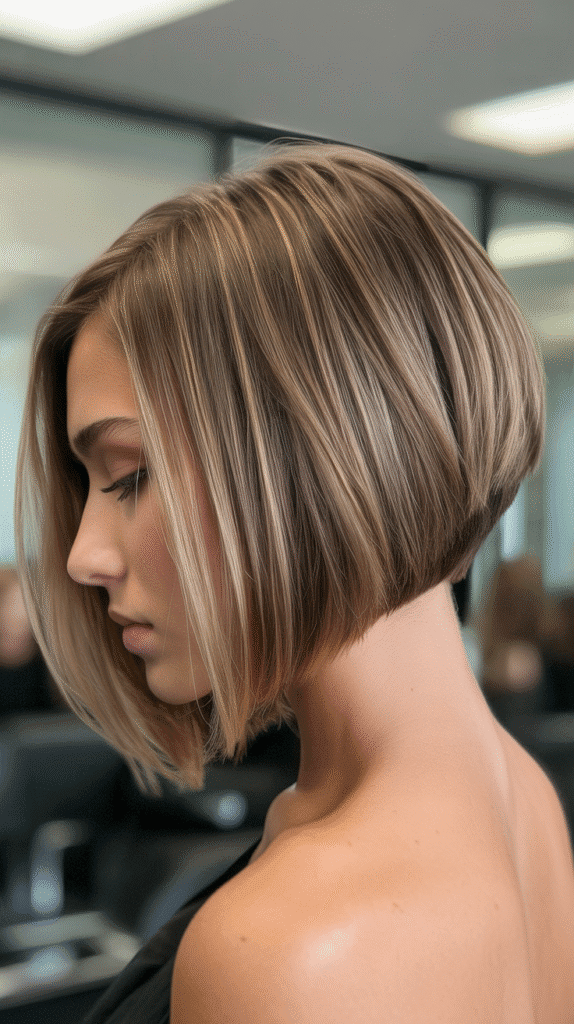
Even within fine hair texture, density varies significantly between individuals.
Customizing the stacked bob approach based on whether hair is fine-and-sparse versus fine-but-abundant optimizes results.
- Low-density fine hair requires more conservative stacking with layers that don’t remove too much length, preserving every possible strand to maintain the appearance of fullness.
- Medium-density fine hair can handle more dramatic stacking and texturing, as there’s sufficient hair quantity to work with even when creating significant graduation and layering.
- Very sparse fine hair benefits from blunt cutting approaches combined with gentle stacking, focusing on weight retention at the perimeter while creating strategic lift at the crown only.
- Understanding individual density helps determine appropriate undercut usage—those with very sparse hair may find undercuts remove too much valuable hair, while medium density benefits from the contrast.
- The consultation process should include assessing both strand thickness (texture) and hair quantity (density) separately, as these distinct characteristics require different cutting approaches for optimal results.
31. Stacked Bob with Seasonal Styling Adaptations
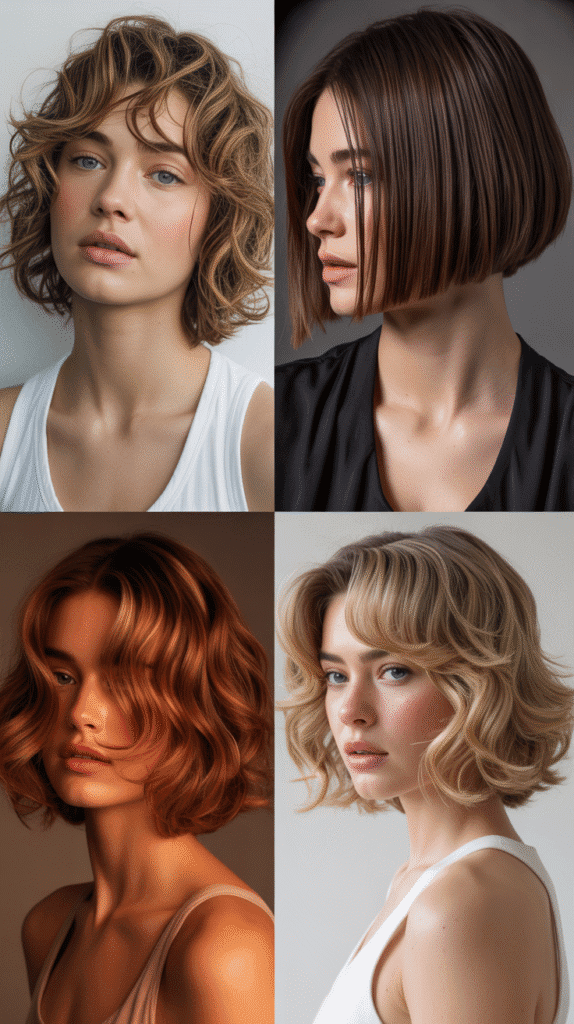
The stacked inverted bob adapts beautifully across seasons, with styling modifications that address weather-related challenges while maintaining the cut’s volume benefits throughout the year.
- Summer styling emphasizes texture and air-dried looks that work with humidity rather than fighting it, using sea salt sprays and anti-frizz products that don’t weigh down fine hair.
- Winter styling focuses on maintaining moisture and preventing static electricity that makes fine hair fly away, using lightweight leave-in conditioners and ionic blow-dryers that smooth without flatness.
- Fall transition allows for richer, warmer color tones that add dimension to the stacked cut, complementing the seasonal aesthetic while enhancing perceived fullness through color depth.
- Spring styling embraces lighter, brighter tones and softer texture that reflects the season’s fresh energy, often incorporating floral accessories or headbands that add interest to fine hair.
- Weather-appropriate product selection matters significantly—lighter formulations in humid months prevent limpness, while slightly richer products in dry climates prevent static without causing heaviness.
32. Stacked Bob with Transition from Long Hair
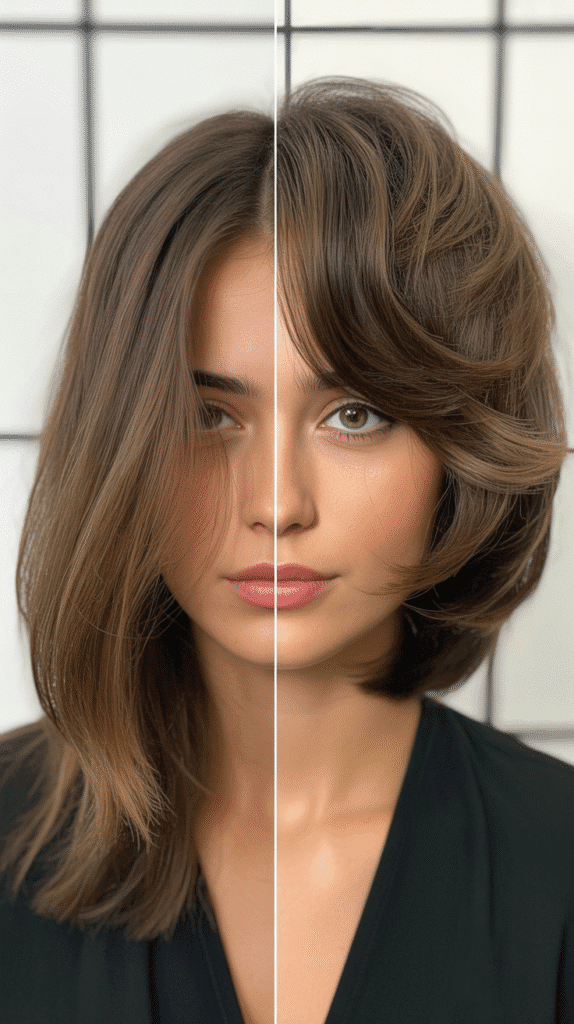
Transitioning from long to a stacked inverted bob requires psychological and practical preparation, particularly when addressing the specific needs of fine, thin hair.
Understanding the transition process ensures satisfaction with dramatic change.
- Gradual transitioning through intermediate lengths (first to collarbone, then to chin, finally to stacked bob) helps those uncertain about short hair adjust psychologically while testing volume benefits at each stage.
- Understanding that fine long hair often appears thinner due to length-weight pulling it flat helps prepare for the dramatic volume increase that occurs when removing that weight through a stacked bob.
- Before photos document the starting point and help track the transformation, often revealing that fine hair looked much thinner when long than clients realized.
- Discussing maintenance differences prepares clients for the reality that shorter stacked cuts require more frequent trims (every 4-6 weeks) than long hair to maintain the precise shape and volume benefits.
- Managing expectations about styling time—some find the stacked bob quicker to style than long hair, while others initially struggle with the techniques required to maximize volume—ensures satisfaction with the transition.
33. Stacked Bob with Nighttime Hair Care Routines
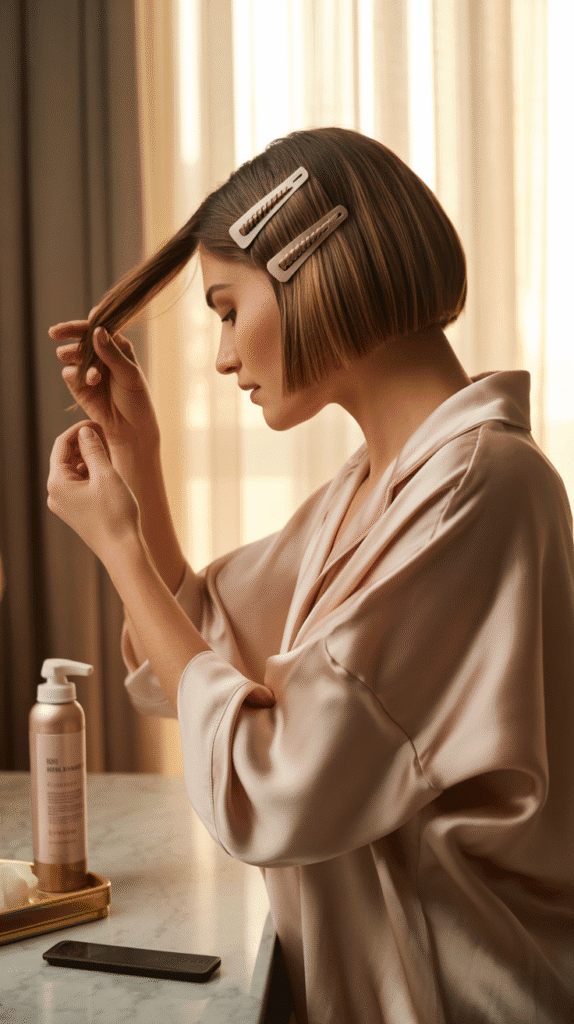
Preserving the stacked bob’s volume between washings requires strategic nighttime routines that prevent flatness while maintaining hair health.
Proper overnight care extends styling longevity for fine hair.
- Silk or satin pillowcases reduce friction that causes fine hair to flatten overnight, helping maintain volume and preventing the breakage that makes thin hair appear even sparser.
- Strategic pinning at the crown using large clips holds volume in place while sleeping, preventing the flattened appearance that occurs when the stacked area is compressed against pillows.
- Dry shampoo application before bed allows the product to absorb oil overnight, providing maximum oil-control benefits by morning and extending time between washings that can stress fine hair.
- Avoiding tight ponytails or buns prevents creasing and maintains the stacked shape—if securing hair is necessary, very loose, low arrangements prevent disrupting the crown volume.
- Morning refresh techniques using texturizing spray and brief targeted blow-drying revive volume without requiring complete restyling, making the stacked bob practical for busy lifestyles.
34. Stacked Bob with Professional Consultation Essentials

Achieving an ideal stacked inverted bob for fine hair begins with thorough professional consultation.
Understanding what to discuss with your stylist ensures customized results that address individual needs and preferences.
- Bringing inspiration photos from multiple angles (front, side, and back views) ensures clear communication about desired stacking height, angle severity, and overall proportions.
- Discussing daily styling routine honestly—including time availability, skill level, and typical products used—helps the stylist customize the cut to work with real-life habits rather than ideal scenarios.
- Addressing specific problem areas like crown flatness, temple thinning, or cowlicks allows the stylist to modify the stacking placement and angle to work with rather than against individual growth patterns.
- Establishing realistic maintenance expectations during consultation prevents disappointment—stacked bobs require regular trims, and fine hair may need specific product investments for optimal results.
- Requesting a styling tutorial during the first appointment ensures you can recreate the volume at home, with the stylist demonstrating techniques specifically for your hair’s texture and density.
35. Stacked Bob with Color Correction Opportunities
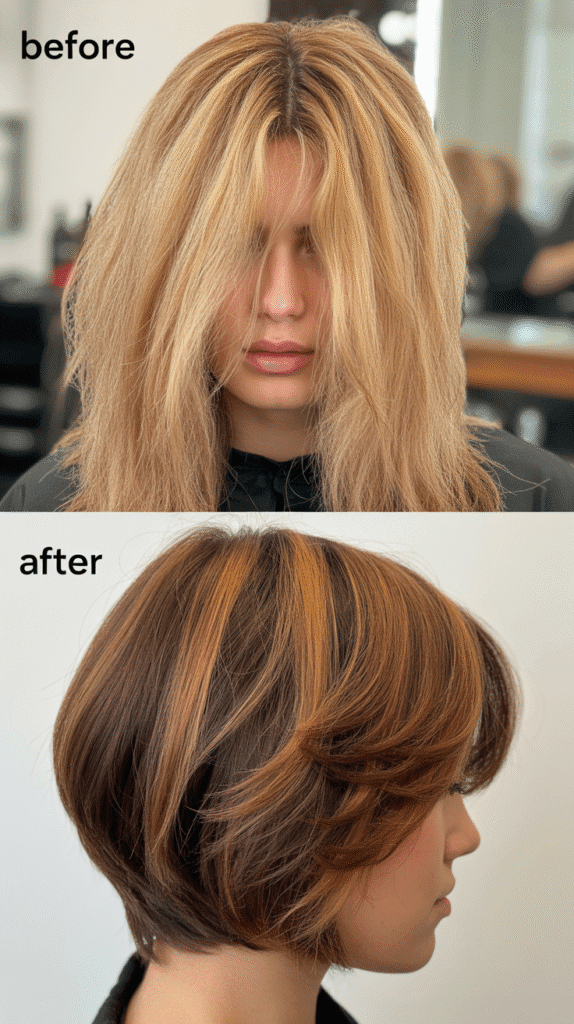
The stacked inverted bob provides an excellent opportunity for color correction when transitioning from damaged, over-processed, or unflattering color while addressing fine hair volume needs simultaneously.
- Removing length through the stacked cut eliminates the most damaged, color-treated ends while the shorter length makes comprehensive color correction more affordable and manageable.
- Transitioning from very light to darker tones becomes easier with shorter hair, as the growing-out phase is shorter and strategic stacking placement can minimize awkward color transition lines.
- The dimensional nature of stacked layers works beautifully with color correction techniques like toning and glazing, as the varied lengths catch light differently and showcase corrected tones effectively.
- Starting fresh with a stacked bob and healthier color creates a foundation for maintaining both cut and color going forward, preventing the cycle of damage that makes fine hair appear even thinner.
- The dramatic transformation of both cut and corrected color provides psychological benefits alongside aesthetic improvement, often dramatically increasing confidence and satisfaction with overall appearance.
36. Stacked Bob with Texture vs. Smoothness Balance

Finding the optimal balance between textured volume and sleek smoothness in a stacked inverted bob depends on individual lifestyle, personal style, and hair characteristics.
Understanding this spectrum allows for personalized customization.
- Maximum texture approaches emphasize choppy layers, piecey separation, and tousled styling that create volume through deliberate dishevelment—ideal for casual lifestyles and contemporary aesthetics.
- Maximum smoothness approaches focus on precise blunt cutting, glossy finishes, and sleek styling that create volume through strategic stacking alone—ideal for professional environments and classic preferences.
- Balanced approaches incorporate elements of both—smooth exterior surfaces with textured interior layers that provide versatility for different occasions and styling moods.
- Hair’s natural characteristics influence the ideal balance—naturally straight fine hair can handle more texture without becoming frizzy, while slightly wavy fine hair may need smoothing to prevent puffiness.
- Experimenting with different styling approaches on the same cut reveals its versatility—the same stacked bob can be worn sleek for work and textured for weekends through different product and tool choices.
37. Stacked Bob with Confidence-Building Transformation
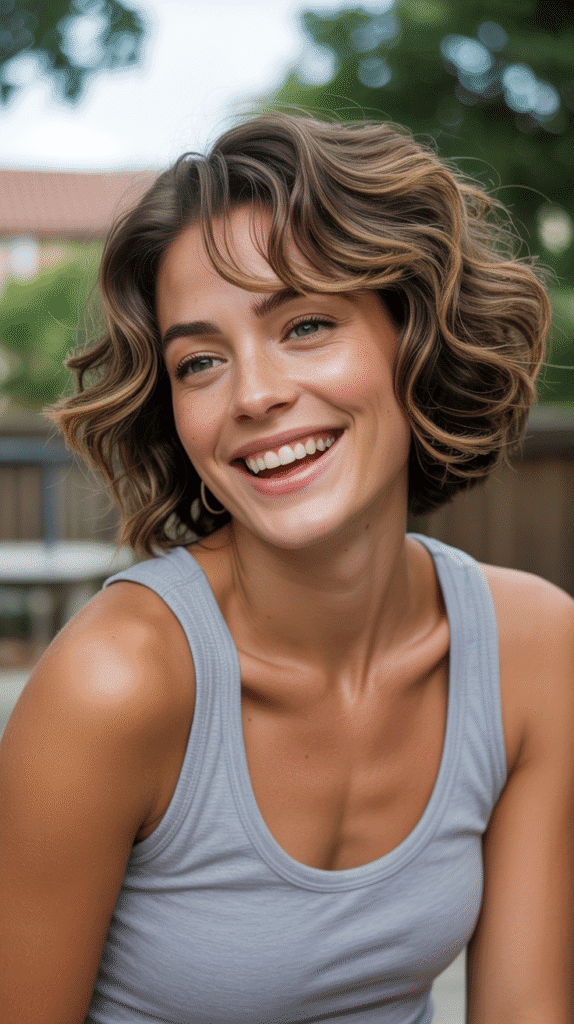
Beyond technical cut details, the stacked inverted bob’s greatest benefit for those with fine, thin hair is the transformative confidence that comes from finally having voluminous, manageable hair that delivers consistent results.
- The dramatic volume increase provides daily affirmation that fine hair doesn’t mean sacrificing style, often leading to increased self-esteem and willingness to try other new styles or looks.
- Receiving compliments on the transformed appearance reinforces the decision to embrace shorter, stacked styling and validates that the cut successfully addresses fine hair challenges.
- The manageable nature of the stacked bob—typically requiring less time and frustration than long fine hair—reduces daily stress and creates positive associations with personal grooming routines.
- Success with a stacked bob often encourages better overall hair care habits, as clients see that their fine hair can look amazing with proper cutting and maintenance, motivating continued investment in hair health.
- The transformation demonstrates that working with hair’s natural characteristics (using strategic stacking for fine texture) rather than fighting against them creates superior results and sustainable satisfaction with appearance.
Conclusion
The journey through these Best 37 Flattering Stacked Inverted Bob Haircuts for Thin Fine Hair reveals that fine hair is not a limitation but an opportunity to showcase strategic styling that creates remarkable volume and dimension.
From classic graduated stacks to contemporary textured variations, each style in this collection addresses the unique challenges of thin, fine hair through thoughtful cutting techniques, strategic layering, and innovative approaches to creating fullness.
The stacked inverted bob stands as a testament to the transformative power of working with your hair’s natural texture rather than against it, offering solutions that range from subtle everyday elegance to bold statement-making drama.
Whether you’re seeking professional polish, casual ease, or edgy fashion-forward style, the versatility of these 37 variations ensures there’s a perfect stacked bob waiting to transform your fine hair from a frustration into your favorite feature.
Armed with the knowledge of cutting techniques, styling methods, product selections, and customization options explored throughout this guide, you’re now prepared to confidently consult with your stylist and embrace the volume, movement, and style that the stacked inverted bob delivers specifically for fine hair textures.
